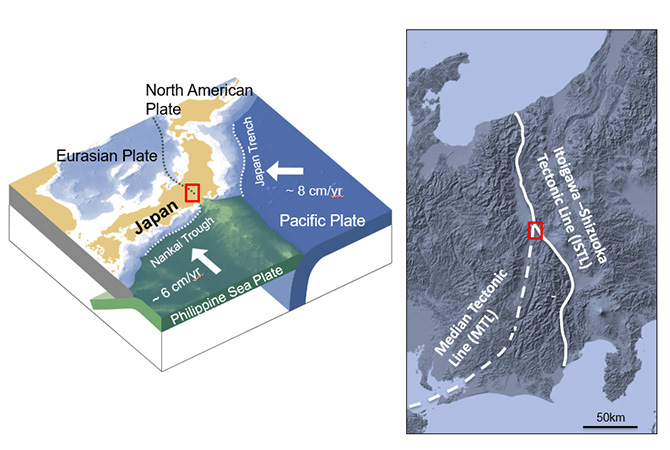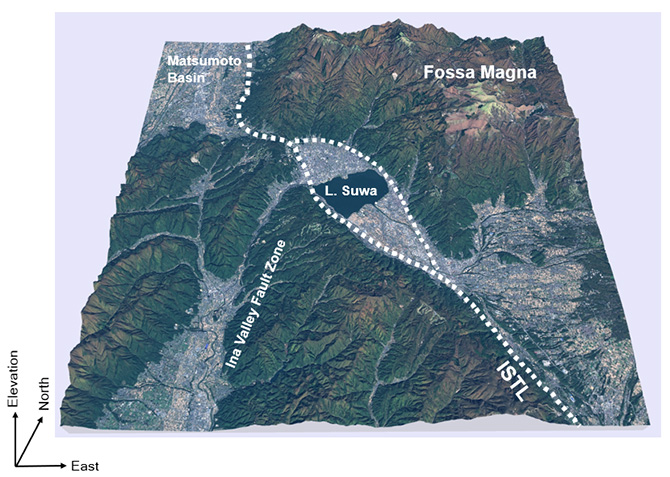Press Releases

JAMSTEC
SHINSHU UNIVERSITY
Atmosphere and Ocean Research Institute,
The University of Tokyo
Identification of molecular species of deep gas seeping from fault lake at plate boundary, and elucidation of its contribution to carbon cycle
―Understanding the mystery of the big hole that appears in lake ice during midwinter season―
1. Key Points
- ◆
- Detailed analysis of the gas seeping from the fault lake located on the Itoigawa-Shizuoka Tectonic Line (Lake Suwa) clarified that methane was the main component originating from the deep carbon.
- ◆
- It was found that the impact of this seep gas that originated from the deep carbon was also transmitted to the primary producer and ecosystems on the surface hydrosphere.
- ◆
- Researchers anticipate a better understanding of the overall picture of the carbon cycle of this “geological hotspot” and elucidation of the food chain in aquatic ecosystems by evaluating the balance of heat flow from the deep sub-surface and detailed chemical flux data.
2. Overview
Dr. Yoshinori Takano and Dr. Atsushi Urai, Biogeochemistry Research Center of the Research Institute for Marine Resources Utilization of JAMSTEC(President: Hiroyuki Yamato), identified the molecular species of the main component of the gas (video) that is actively seeping from Lake Suwa, which is a representative fault lake, and clarified its origin, in collaboration with Shinshu University and the Atmosphere and Ocean Research Institute of the University Tokyo.
Lake Suwa is a fault lake located on the Itoigawa-Shizuoka Tectonic Line(ISTL), which itself is located on the boundary between the North American and Eurasian Plates (Fig. 1), with active seeping gas being confirmed at multiple locations in the lake. This “geological hotspot” forms big holes in the midwinter season (Fig. 2), which then influence the lake ice heterogeneity. However, the overall understanding of the biogeochemical cycle, including the main components and origins of these gases and their dynamics after being released into the surface hydrosphere, remain largely unknown.
In the present study, the researchers focused on the molecular species present in the gas and conducted a precise molecular-specific stable carbon isotope ratio/radiocarbon isotope ratio (*1) analysis. These results showed that the main component of seep gas was methane, which originated from deep carbon. These results also involved a quantitative evaluation of the previously-unknown contribution of deep seeping gas and the surface hydrosphere to the carbon cycle; in the future, these are expected to enable the elucidation of the carbon cycle in fault lakes and the food chain in aquatic ecosystems.
This research represents joint research between JAMSTEC and Shinshu University. The results will be published in the specialized academic journal ACS Earth and Space Chemistry, which is published by the American Chemical Society, on June 15 (JST).
- JAMSTEC
- Shinshu University
- Atmosphere and Ocean Research Institute, The University of Tokyo
【Supplemental Information】
- *1
- Radiocarbon isotope ratio:
The ratio of two types of carbon isotopes with different mass numbers (14C/12C). Carbon mainly exhibits mass numbers of 12, 13, and 14 (12C, 13C, and 14C). 14C is a radioisotope and has a half-life of 5,730 years. 14C is generated by the reaction of nitrogen in the atmosphere and cosmic rays. Although 14C rapidly spreads through the atmosphere, hydrosphere, and biosphere, 14C is reduced in the geosphere where there is no supply of atmospheric carbon. Therefore, measuring underground 14C levels enables the determination of whether there is an exchange between the underground environment and the atmosphere, or if the underground environment is isolated from the atmosphere.


Fig.1 Positional relationship between the Itoigawa-Shizuoka Tectonic Line and Median Tectonic Line (top), and an aerial view of Lake Suwa (bottom) (referenced from the Geospatial Information Authority of Japan). Lake Suwa is a fault lake formed on the Itoigawa-Shizuoka Tectonic Line and is located at the intersection with the Median Tectonic Line.

Fig.2 Presence of a big hole that appears in Lake Suwa in midwinter (January 2022). Discharge of fluids from the deep sub-surface has been identified in several locations, and big holes with a diameter of at least 40 m form even when the lake is completely frozen in midwinter.
Contacts
- (For this study)
- Yoshinori Takano, Principal Researcher, or Atsushi Urai, JSPS Research Fellow, Research Institute for Marine Resources Utilization(MRU), Biogeochemistry Research Center (BGC), JAMSTEC
- (For press release)
- Press Office, Marine Science and Technology Strategy Department, JAMSTEC
- Office of Public Relations, Department of General Affairs,
Shinshu University - Public Relations Office, Center for Cooperative Research Promotion,
Atmosphere and Ocean Research Institute, The University of Tokyo